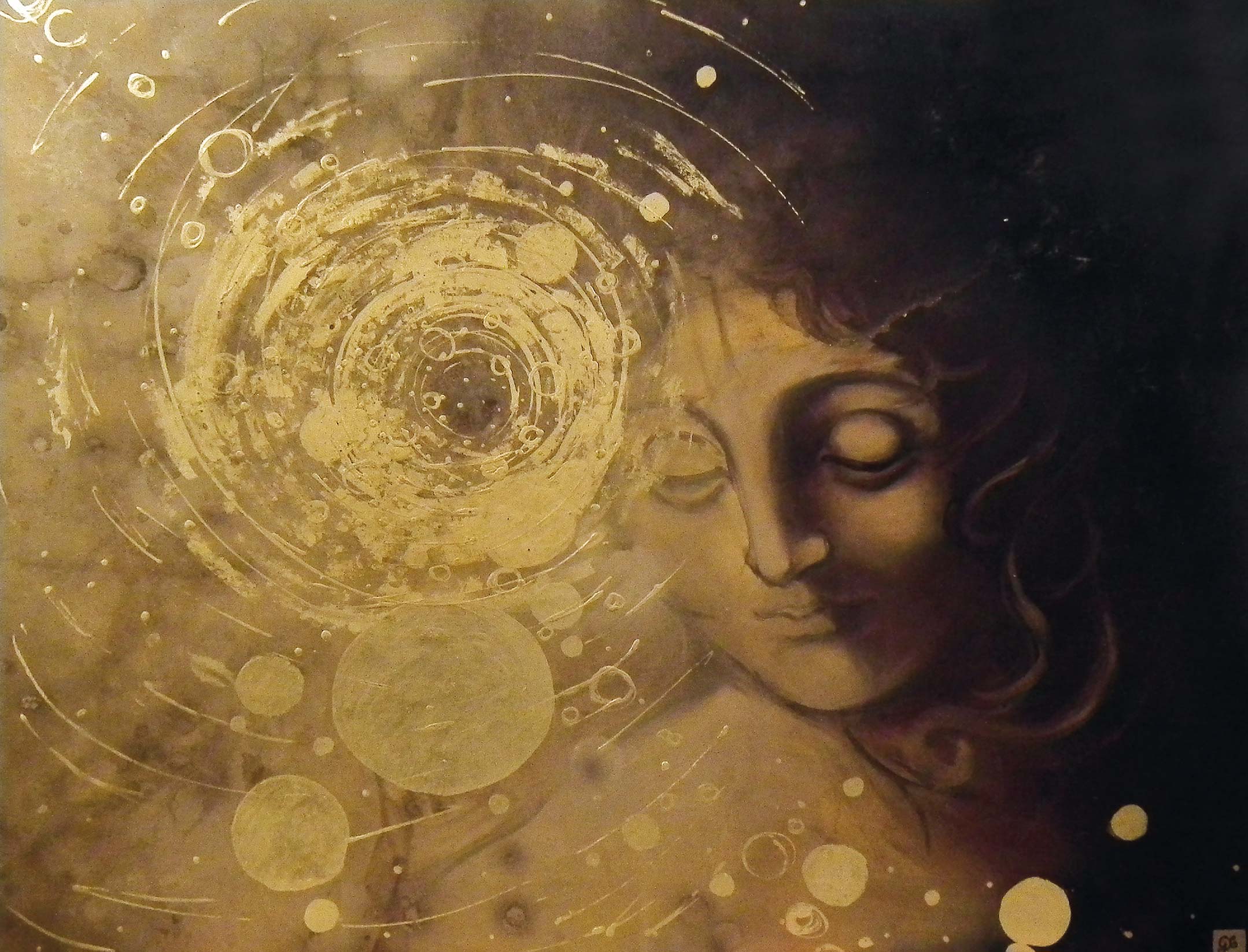
Oggi vi parlo di… Sviluppo di un Pensiero
10 gennaio 2025
(English text below, at the end of Italian version) (Version Française après l’italienne et l’anglaise)
Oggi vi voglio parlare di una mia opera, Sviluppo di un Pensiero, concepita in sequenza all’opera Nascita di un Pensiero (che purtroppo ha subito alcuni danni che mi costringono a restaurarla prima di poterla nuovamente mostrare), ed esposta per la prima volta nel contesto della mostra Sguardi Segreti – Oggi e Leonardo, realizzata per il cinquecentenario della morte del grande genio, nel 2019.
Due dati tecnici, per essere completamente esaustiva anche da questo punto di vista. È un dipinto ad olio su tela, le sue misure sono 80x100cm. Oltre alla pittura ad olio ho impiegato colori in bomboletta spray, foglia d’oro di 24 carati e resina epossidica.
Quando mi si è prospettata la possibilità di creare un percorso espositivo in onore di Leonardo da Vinci e per giunta in un luogo frequentato da lui stesso quale la Basilica di Santa Maria delle Grazie a Milano, la gioia è stata grande e la responsabilità ancor di più. Copiare non è mai stato nelle mie corde, anche quando ero al liceo e dovevo copiare i modelli dal vero, figuriamoci copiare Leonardo per fargli omaggio! Non volevo cadere nella triste scopiazzatura senz’anima e poi, io non sono Leonardo da Vinci, ho il mio stile e la mia poetica. Un misto tra senso morale, orgoglio, coscienza dei miei limiti ma anche voglia di imparare mi ha guidata. Ho pensato così di ispirarmi liberamente alle sue opere e cercare di comprenderne la tecnica esecutiva e il messaggio veicolato.
Leonardo da Vinci… pittore dell’anima e del misterioso mondo che si cela dietro gli occhi delle persone che proprio lui definiva “finestre dell’anima”. Da questo punto di vista siamo in sintonia. Anche io ho sempre cercato di trasmettere sentimenti ed emozioni del soggetto rappresentato. André Chastel che ha scritto di Leonardo da Vinci ha parlato di “chiaroscuro del pensiero”. Emozioni fugaci che si susseguono tra luce ed ombra, pensieri veloci o lenti e soffusi… questo ho cercato.

Nello stesso periodo stavo seguendo anche una mia idea a cavallo tra teoria e pratica, che ho cercato di far emergere nei quadri realizzati per la mia mostra “leonardesca”. Questa idea, che tutt’ora è presente nella mia ricerca artistica, arriva ad un ribaltamento della logica rappresentazione della realtà, ma andiamo con ordine.
Durante qualsiasi tipo di studi, ma anche nella nostra esperienza quotidiana, è facile imparare e riscontrare che la luce illumina il mondo e grazie ad essa noi possiamo vederlo tramite i nostri occhi. La luce ci fa conoscere visivamente la realtà, questo è un dato di fatto.
Ora spostiamoci nel contesto dell’arte. Anche qui vediamo spesso come la parte in luce di un soggetto dipinto è quella più dettagliata e decifrabile, mentre invece la parte in ombra sfuma fino a perdersi nell’ombra. Fin qui non ci sono problemi, ma ho spiegato più volte che la mia arte è spesso anche simbolica. Nascondo simboli veri e propri oppure uso colori che possono celare un messaggio ulteriore. Nel caso di questo dipinto come di molti altri presenti alla mostra del ’19, ho usato il bruno Van Dick, la terra di Cassel e altre tinte riconducibili alla terra, sia per composizione chimica, sia per corrispondenza cromatica. Color terra, colore della terra, colore che simboleggia la terra, la parte terrena e materiale di un soggetto. Parte conoscibile, ben visibile all’occhio umano perché appartiene al nostro mondo sensoriale e, di conseguenza, nei miei dipinti la parte più descrittiva e osservabile. Ecco che si profila il ribaltamento… ma continuo. Continuando a parlare da un punto di vista simbolico, la luce allora non è solo luce, ma Luce. Dalla mia prima mostra Tra Terra e Cielo il Tuo Volto, la luce che rappresento ha le caratteristiche di Luce divina, che illumina interiormente e trascende. Come nelle pale gotiche, l’oro è il metallo del divino, le luci che dipingo sono dorate. Esse parlano di quella sfera spirituale che non è percepibile dai sensi ma solo al di là di essi, e che rimane appena percepibile, mai conoscibile del tutto perché non appartenente al mondo sensoriale. Ecco quindi che la luce delle mie opere non svela il soggetto allo spettatore, ma piuttosto sembra renderlo meno accessibile là dove lo colpisce. Il dipinto rimane un “non finito” di stampo michelangiolesco, che si arresta quando si arriva al limite dell’inspiegabile. Tornando alla pratica, tutto questo comporta che laddove il soggetto è in ombra, i dettagli siano più definiti, dove invece è colpito dalla luce, l’opera rimanga appena accennata. Ecco il ribaltamento della rappresentazione logica della realtà. La logica vuole che un oggetto più è illuminato, più si vede; nei miei dipinti è l’esatto contrario.
Tutto quello che vi ho spiegato finora è riscontrabile in Sviluppo di un Pensiero. Questo dipinto, che è stato tra i più apprezzati durante la mia ultima mostra Ricercando l’Imponderabile a Bergamo, ha inoltre ben visibili i “miei” cerchi dorati, simboli ricorrenti nella mia arte, che accennano al mondo delle Idee platoniche. Imperfetti ma dorati sono pensieri elevati che si avvicinano alle Idee perfette dell’Iperuranio e che ne sono un leggero riflesso. La donna dipinta ha la postura della Leda di Da Vinci, ho osservato attentamente i suoi bozzetti e la meravigliosa Scapigliata prima di dipingerla senza più guardarla. È così che la memoria si fonde alla mia fantasia e al mio personale sentire e sono stata in grado di creare qualcosa che si riferisce a Leonardo senza copiarlo; è così che ho dipinto cercando il suo cuore e in esso quella parte che si accordasse col mio.
Giulia Calvanese
–English text, with google translator help-
January 10, 2025
Today I want to talk to you about one of my works, Sviluppo di un Pensiero, conceived in sequence to the work Nascita di un Pensiero (which unfortunately suffered some damage that forced me to restore it before being able to show it again), and exhibited for the first time in the context of the exhibition Sguardi Segreti – Oggi e Leonardo, created for the five hundredth anniversary of the death of the great genius, in 2019.
Two technical data, to be completely exhaustive also from this point of view. It is an oil painting on canvas, its dimensions are 80x100cm. In addition to oil painting, I used spray paint, 24-carat gold leaf and epoxy resin.
When I was presented with the possibility of creating an exhibition path in honor of Leonardo da Vinci and moreover in a place frequented by him himself such as the Basilica of Santa Maria delle Grazie in Milan, the joy was great and the responsibility even greater. Copying has never been my thing, even when I was in high school and had to copy models from life, let alone copy Leonardo to pay homage to him! I didn’t want to fall into sad soulless copying and then, I’m not Leonardo da Vinci, I have my own style and my own poetics. A mix of moral sense, pride, awareness of my limits but also desire to learn guided me. So I thought of drawing free inspiration from his works and trying to understand the executive technique and the message conveyed.
Leonardo da Vinci… painter of the soul and of the mysterious world that lies behind the eyes of people that he himself defined as “windows of the soul”. From this point of view we are in tune. I too have always tried to convey feelings and emotions of the subject represented. André Chastel who wrote about Leonardo da Vinci spoke of “chiaroscuro of thought”. Fleeting emotions that follow one another between light and shadow, fast or slow and suffused thoughts… this is what I sought.
In the same period I was also following an idea of mine between theory and practice, which I tried to bring out in the paintings made for my “Leonardesque” exhibition. This idea, which is still present in my artistic research, leads to a reversal of the logical representation of reality, but let’s go in order.
During any type of study, but also in our daily experience, it is easy to learn and find that light illuminates the world and thanks to it we can see it through our eyes. Light makes us visually know reality, this is a fact.
Now let’s move to the context of art. Here too we often see how the part in light of a painted subject is the most detailed and decipherable, while the part in shadow fades until it gets lost in the shadow. So far there are no problems, but I have explained several times that my art is often also symbolic. I hide real symbols or I use colors that can conceal a further message. In the case of this painting, as in many others at the 1919 exhibition, I used Van Dick brown, Cassel earth and other shades that can be traced back to the earth, both in terms of chemical composition and chromatic correspondence. Earth color, the color of the earth, a color that symbolizes the earth, the earthly and material part of a subject. A knowable part, clearly visible to the human eye because it belongs to our sensorial world and, consequently, in my paintings the most descriptive and observable part. Here the reversal emerges… but I continue. Continuing to speak from a symbolic point of view, light is not just light, but Light. Since my first exhibition Between Earth and Sky Your Face, the light I represent has the characteristics of divine Light, which illuminates internally and transcends. As in Gothic altarpieces, gold is the metal of the divine, the lights I paint are golden. They speak of that spiritual sphere that is not perceptible by the senses but only beyond them, and that remains barely perceptible, never fully knowable because it does not belong to the sensorial world. So the light of my works does not reveal the subject to the viewer, but rather seems to make it less accessible where it strikes him. The painting remains an “unfinished” in the style of Michelangelo, which stops when it reaches the limit of the inexplicable. Returning to practice, all this means that where the subject is in the shadow, the details are more defined, whereas where it is struck by light, the work remains barely hinted at. Here is the reversal of the logical representation of reality. Logic dictates that the more an object is illuminated, the more it is seen; in my paintings it is the exact opposite.
Everything I have explained so far can be found in Sviluppo di un Pensiero. This painting, which was among the most appreciated during my last exhibition Ricercando l’Imponderabile in Bergamo, also has clearly visible “my” golden circles, recurring symbols in my art, which hint at the world of Platonic Ideas. Imperfect but golden, they are elevated thoughts that come close to the perfect Ideas of the Hyperuranion and are a light reflection of them. The painted woman has the posture of Da Vinci’s Leda, I carefully observed his sketches and the wonderful Scapigliata before painting her without looking at her anymore. This is how memory merges with my imagination and my personal feeling and I was able to create something that refers to Leonardo without copying him; this is how I painted looking for his heart and in it that part that agreed with mine.
Giulia Calvanese
-Version Française-
Aujourd’hui, je veux vous parler d’une de mes œuvres, Développement d’une pensée, conçue en séquence avec l’œuvre Naissance d’un Pensiero (qui a malheureusement subi quelques dommages qui m’ont obligé à la restaurer avant de pouvoir la montrer à nouveau), et exposée pour la première fois dans le cadre de l’exposition Sguardi Segreti – Oggi e Leonardo (Regards secrets – Aujourd’hui et Léonard), créée pour le cinq centième anniversaire de la mort du grand génie, en 2019.
Deux données techniques, pour être complètement exhaustif également de ce point de vue. C’est une peinture à l’huile sur toile, ses dimensions sont de 80x100cm. En plus de la peinture à l’huile, j’ai utilisé de la peinture en aérosol, de la feuille d’or 24 carats et de la résine époxy.
Quand on m’a proposé de réaliser une exposition en l’honneur de Léonard de Vinci, et de plus dans un lieu fréquenté par lui-même, comme la Basilique Santa Maria delle Grazie à Milan, la joie a été grande et la responsabilité encore plus grande. Copier n’a jamais été mon truc, même quand j’étais au lycée et que je devais copier des modèles sur le vif, et encore moins copier Léonard pour lui rendre hommage ! Je ne voulais pas tomber dans le copier-coller triste et sans âme et puis, je ne suis pas Léonard de Vinci, j’ai mon propre style et ma propre poétique. Un mélange de sens moral, de fierté, de conscience de mes limites mais aussi d’envie d’apprendre m’a guidé. J’ai donc pensé que je pourrais m’inspirer librement de ses œuvres et essayer de comprendre sa technique d’exécution et le message qu’il véhiculait.
Léonard de Vinci… peintre de l’âme et du monde mystérieux qui se cache derrière les yeux des gens qu’il définissait lui-même comme les « fenêtres de l’âme ». De ce point de vue, nous sommes en phase. Moi aussi, j’ai toujours essayé de transmettre les sentiments et les émotions du sujet représenté. André Chastel, qui a écrit sur Léonard de Vinci, parlait du « clair-obscur de la pensée ». Des émotions fugaces qui se succèdent entre ombre et lumière, des pensées rapides ou lentes et douces… c’est ce que je recherchais.
En même temps, je poursuivais également une idée qui m’était propre, à cheval entre théorie et pratique, et que j’essayais de faire ressortir dans les peintures créées pour mon exposition « Léonardesque ». Cette idée, toujours présente dans ma recherche artistique, conduit à un renversement de la représentation logique de la réalité, mais procédons dans l’ordre.
Au cours de tout type d’études, mais aussi dans notre expérience quotidienne, il est facile d’apprendre et de découvrir que la lumière illumine le monde et grâce à elle nous pouvons le voir à travers nos yeux. La lumière nous rend visuellement conscient de la réalité, c’est un fait.
Passons maintenant au contexte de l’art. Ici aussi, nous voyons souvent comment la partie éclairée d’un sujet peint est la plus détaillée et la plus déchiffrable, tandis que la partie dans l’ombre s’estompe jusqu’à se perdre dans l’ombre. Jusqu’à présent, il n’y a pas de problèmes, mais j’ai expliqué à plusieurs reprises que mon art est souvent aussi symbolique. Je cache des symboles réels ou j’utilise des couleurs qui peuvent masquer un message supplémentaire. Dans le cas de ce tableau, comme pour beaucoup d’autres présents à l’exposition de 1919, j’ai utilisé du brun Van Dick, de la terre de Cassel et d’autres nuances attribuables à la terre, tant en termes de composition chimique que de correspondance chromatique. Couleur terre, couleur de la terre, couleur qui symbolise la terre, la partie terrestre et matérielle d’un sujet. Partie connaissable, clairement visible à l’œil humain car elle appartient à notre monde sensoriel et, par conséquent, dans mes peintures, la partie la plus descriptive et observable. Et voilà le renversement… mais il continue. Pour continuer à parler d’un point de vue symbolique, la lumière n’est alors pas seulement lumière, mais Lumière. Depuis ma première exposition Entre Terre et Ciel Ton Visage, la lumière que je représente a les caractéristiques de la Lumière divine, qui illumine intérieurement et transcende. Comme dans les retables gothiques, l’or est le métal du divin, les lumières que je peins sont dorées. Ils parlent de cette sphère spirituelle qui n’est pas perceptible par les sens mais seulement au-delà d’eux, et qui reste à peine perceptible, jamais pleinement connaissable parce qu’elle n’appartient pas au monde sensoriel. Ainsi, la lumière dans mes œuvres ne révèle pas le sujet au spectateur, mais semble plutôt le rendre moins accessible là où il le frappe. Le tableau reste une œuvre « inachevée » dans le style de Michel-Ange, qui s’arrête lorsqu’elle atteint la limite de l’inexplicable. Pour revenir à la pratique, tout cela fait que là où le sujet est dans l’ombre, les détails sont plus définis, alors que là où il est frappé par la lumière, l’œuvre reste à peine esquissée. Voici le renversement de la représentation logique de la réalité. La logique veut que plus un objet est éclairé, plus il est visible ; dans mes peintures c’est exactement le contraire.
Tout ce que j’ai expliqué jusqu’à présent se trouve dans Développement d’une pensée. Ce tableau, qui a été parmi les plus appréciés lors de ma dernière exposition Ricercando l’Imponderabile à Bergame, montre aussi clairement « mes » cercles dorés, symboles récurrents dans mon art, qui font allusion au monde des Idées platoniciennes. Imparfaites mais dorées sont les pensées élevées qui se rapprochent des Idées parfaites de l’Hyperuranion et en sont un léger reflet. La femme peinte a la posture de la Léda de Léda de Vinci, j’ai observé attentivement ses esquisses et la merveilleuse Scapigliata avant de la peindre sans plus la regarder. C’est ainsi que la mémoire fusionne avec mon imagination et mon sentiment personnel et j’ai pu créer quelque chose qui fait référence à Léonard sans le copier ; C’est ainsi que j’ai peint, à la recherche de son cœur et de cette partie de celui-ci qui correspondait au mien.
Giulia Calvanese

